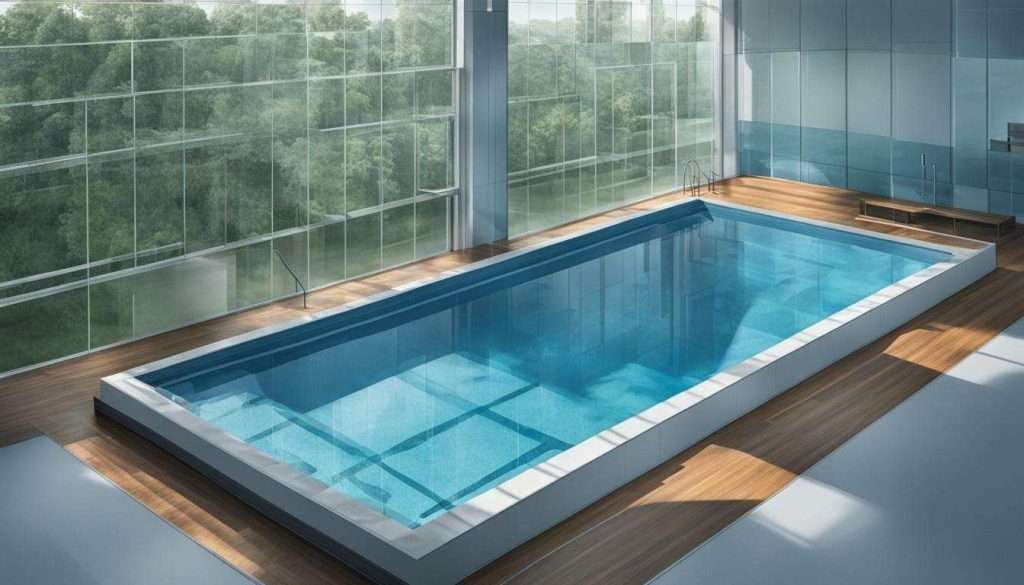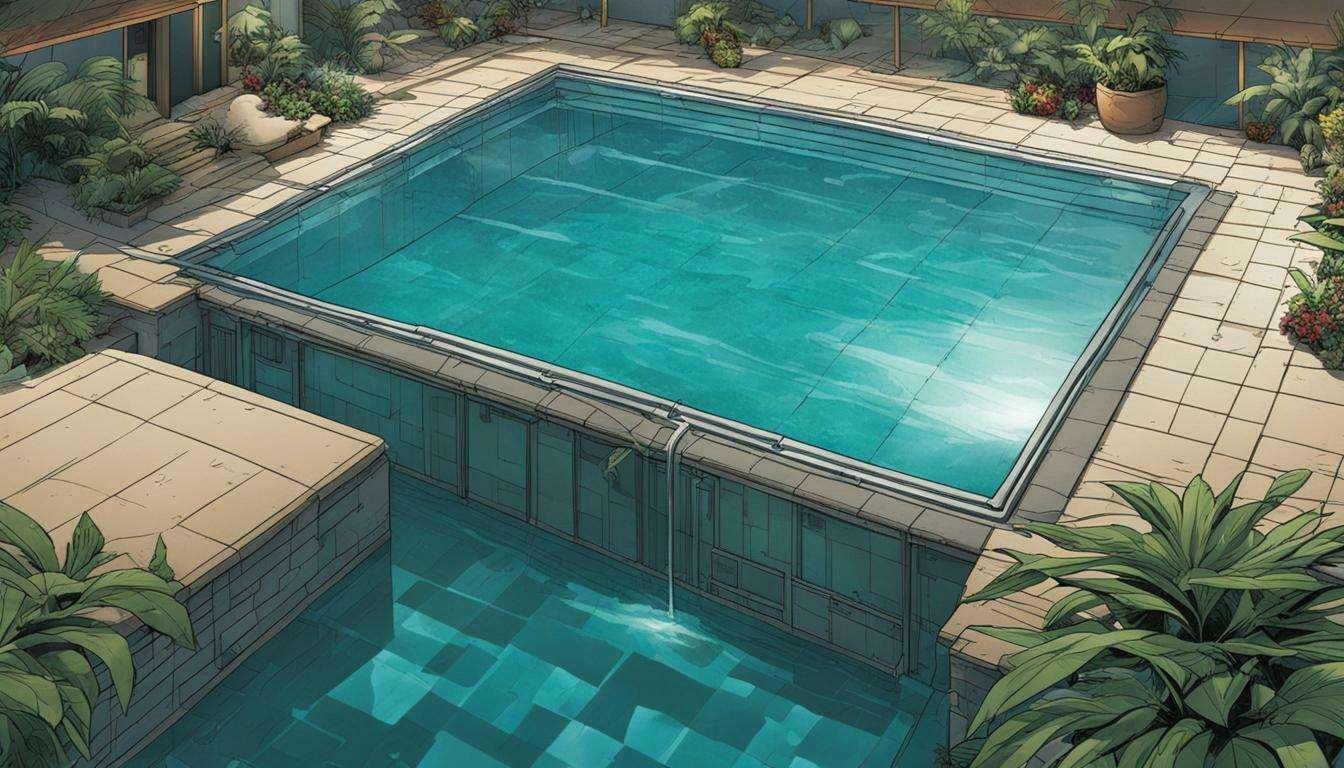Many pool owners wonder if it is feasible to use a pool cover for their indoor oasis. Indoor pool covers, such as foam covers or bubble covers, are primarily used for energy savings and heat retention in indoor pools. Safety covers are rarely used for indoor pools, as they are typically open year-round. Indoor pool covers can reduce evaporation, heat loss, and the need for ventilation, resulting in significant energy savings. They also help maintain water chemistry by preventing off-gassing of chloramines and reducing pH levels. However, pool covers do not improve indoor air quality and may prolong chloramine issues. Overall, using an indoor pool cover can be beneficial for energy savings and water chemistry control in indoor pools.
Key Takeaways
- Using a pool cover for an indoor pool can result in energy savings and heat retention.
- Indoor pool covers reduce evaporation, heat loss, and the need for ventilation.
- Pool covers help maintain water chemistry by preventing off-gassing of chloramines and reducing pH levels.
- However, pool covers do not improve indoor air quality and may prolong chloramine issues.
- Overall, using an indoor pool cover can be beneficial for energy savings and water chemistry control in indoor pools.
Advantages of using a pool cover for an indoor pool
Using a pool cover for your indoor pool comes with numerous advantages. These specially designed covers provide a range of benefits that can enhance your indoor pool experience and save you money in the long run. In addition to energy savings by reducing heating costs, using a tarp for pool cover can also help keep your indoor pool clean and reduce the frequency of maintenance. These covers prevent debris like leaves and dust from accumulating in the water, ensuring a pleasant swimming environment. Furthermore, they help to retain heat, making your pool enjoyable year-round. One significant advantage is the ability to maintain water temperature, making it more comfortable for swimming without excessive heating costs. Additionally, many covers offer excellent pool cover compatibility with heaters, ensuring that your pool retains heat more efficiently. This compatibility also helps reduce wear and tear on heating systems, ultimately extending their lifespan. In addition to reducing heating costs and minimizing maintenance, pool covers also help maintain water quality by limiting debris exposure. There are various pool cover options for protection that cater to different needs, ensuring you can find the perfect fit for your indoor oasis. By investing in a suitable cover, you can create a safer environment and extend the longevity of your pool area. One of the significant benefits of pool covers is their ability to maintain water temperature, reducing heating costs and energy consumption. Additionally, these covers can help keep debris out of the pool, minimizing maintenance efforts and ensuring a cleaner swimming environment. Overall, understanding the benefits of pool covers can help you make an informed decision that enhances your enjoyment while lowering operational expenses.
One of the key advantages of using an indoor pool cover is the energy-saving potential. By covering your pool when it’s not in use, you can minimize heat loss and reduce the need for additional heating. This not only helps to maintain a comfortable swimming temperature but also significantly lowers your energy costs.
Additionally, indoor pool covers are effective at retaining heat. They create a barrier that prevents warmth from escaping, ensuring that your pool stays at the desired temperature for longer periods. This is especially beneficial during colder months or in regions with unpredictable weather, allowing you to enjoy your indoor pool all year round.
Another advantage is the reduced evaporation that pool covers offer. Evaporation can lead to water loss, which not only affects your pool’s water levels but also increases the need for chemical treatments. By covering your indoor pool, you can significantly reduce evaporation and conserve water, saving you both time and money on maintenance and chemical costs.
| Advantages of using a pool cover for an indoor pool |
|---|
| Energy savings |
| Heat retention |
| Reduced evaporation |
As you can see, using a pool cover for your indoor pool has multiple benefits. Not only can it help you save on energy costs and maintain a comfortable swimming temperature, but it can also reduce water loss and the need for chemical treatments. Investing in an indoor pool cover is a wise choice for any pool owner looking to enhance their swimming experience and reduce ongoing maintenance expenses.

Before investing in a pool cover for your indoor pool, it’s important to consider a few key factors. Indoor pool covers, such as foam covers or bubble covers, offer benefits like energy savings and heat retention. However, they may not be suitable for all indoor pool setups.
First, you should assess the size and shape of your indoor pool. Pool covers come in different sizes and configurations, so it’s crucial to choose one that fits your pool properly. Measure your pool accurately, taking into account any irregularities or unique features.
Next, consider the type of pool cover that best suits your needs. Foam covers provide excellent insulation and heat retention, making them ideal for indoor pools. Bubble covers, on the other hand, are lightweight and easy to handle, but they may not provide the same level of insulation as foam covers. Evaluate the specific requirements of your indoor pool to determine which type of cover is most suitable.
Finally, think about the maintenance and durability of the pool cover. Ensure that the cover you choose is easy to clean and maintain, as this will prolong its lifespan. Additionally, consider the warranty and quality of the cover to ensure you’re making a wise investment.
| Considerations | Benefits |
|---|---|
| Size and shape of pool | Proper fit for optimal performance |
| Type of cover | Energy savings and heat retention |
| Maintenance and durability | Prolonged lifespan and value for money |
By carefully considering these factors, you can make an informed decision about using a pool cover for your indoor pool. Remember that each pool is unique, so it’s essential to choose a cover that meets your specific requirements and provides the desired benefits.
Energy-saving potential of indoor pool covers
One of the primary reasons to consider using a pool cover for your indoor pool is the significant energy-saving potential it offers. Indoor pool covers, such as foam covers or bubble covers, are designed to reduce heat loss, evaporation, and the need for ventilation, resulting in substantial energy savings. By acting as a barrier, these covers prevent heat from escaping the pool, keeping the water temperature warm and reducing the workload of heating systems. This not only saves on energy costs but also helps to create a more sustainable and environmentally friendly pool.
In addition to heat retention, indoor pool covers also play a crucial role in reducing water evaporation. Evaporation is a natural process that occurs when water turns into vapor, causing heat loss. By covering the pool surface, the cover minimizes water evaporation, which in turn reduces the amount of heat that needs to be replaced. This means less energy is consumed to maintain the desired water temperature, leading to significant energy savings over time.
Moreover, using an indoor pool cover can help maintain proper water chemistry. Chlorine and other sanitizing agents used in pools can combine with organic compounds, such as sweat and urine, to form chloramines. These chloramines can cause eye and skin irritation, as well as a strong odor. However, when pool covers are in place, they prevent off-gassing of chloramines into the indoor air, reducing the unpleasant smell and potential health hazards. Additionally, pool covers help to lower pH levels as they inhibit the entry of carbon dioxide, which can contribute to water acidity. Consequently, cleaner and healthier water can be maintained with less reliance on chemical treatments.

While indoor pool covers offer significant energy-saving potential, it is important to note that they do not improve indoor air quality. In fact, they can exacerbate air quality issues by trapping chloramines inside the pool enclosure. These trapped chloramines may require additional treatment and ventilation measures to mitigate their effects on air quality. It is crucial for pool owners to strike a balance between energy savings and maintaining a healthy indoor environment by implementing proper ventilation systems alongside the use of pool covers.
| Key benefits of using a pool cover for an indoor pool: |
|---|
| Significant energy savings through heat retention |
| Reduced water evaporation and heat loss |
| Maintained water chemistry and reduced chloramine off-gassing |
In summary, using a pool cover specifically designed for indoor pools can provide numerous benefits, including substantial energy savings, reduced water evaporation, and improved water chemistry. By properly utilizing pool covers and implementing effective ventilation systems, pool owners can create a more energy-efficient and comfortable indoor pool environment.
Water chemistry control and indoor pool covers
Using a pool cover for your indoor pool can have a positive impact on water chemistry and quality. Indoor pool covers, such as foam covers or bubble covers, help maintain a cleaner and healthier water environment by preventing the off-gassing of chloramines and reducing pH levels. Chloramines, formed when chlorine reacts with organic matter, can cause eye and skin irritation, as well as give off a strong chlorine smell. By keeping the pool covered, you can minimize the buildup of chloramines and improve the overall water quality.
The use of an indoor pool cover also minimizes chemical evaporation. When a pool is uncovered, chemicals, particularly chlorine, can escape into the air. This not only wastes chemicals but also affects the balance of the water, leading to increased expenses and more frequent maintenance. By reducing the rate of evaporation, pool covers ensure that the chemicals remain in the water, maintaining the desired balance and reducing the need for frequent adjustments.
Furthermore, pool covers create a barrier that helps keep debris out of the pool. Leaves, insects, and other organic matter can introduce contaminants into the water, requiring additional chemical treatments to maintain the desired water chemistry. By preventing debris from entering the pool, covers minimize the need for extra chemicals and reduce the time and effort spent on cleaning and maintenance.

In summary, using an indoor pool cover offers several benefits, including energy savings, heat retention, and improved water chemistry. By reducing evaporation and heat loss, pool covers help maintain the water temperature and save on energy costs. They also prevent off-gassing of chloramines and maintain proper pH levels, promoting healthier and cleaner water. While pool covers do not directly improve indoor air quality, they contribute to a better water environment in indoor pools. Consider incorporating a pool cover into your indoor pool maintenance routine to reap these advantages.
Conclusion
Using a pool cover for your indoor pool can bring several advantages, making it a worthy investment for any indoor pool owner. Indoor pool covers, such as foam covers or bubble covers, are primarily used for energy savings and heat retention in indoor pools. These covers can reduce evaporation, heat loss, and the need for ventilation, resulting in significant energy savings.
In addition to energy efficiency, indoor pool covers also play a crucial role in maintaining water chemistry. By preventing off-gassing of chloramines and reducing pH levels, they promote healthier and cleaner water. This is particularly important for indoor pools where air quality can be a concern.
It is important to note that while pool covers offer many benefits for indoor pools, they do not improve indoor air quality. In fact, they may even prolong chloramine issues if proper ventilation is not maintained. Therefore, it is essential to strike a balance between energy savings and ensuring a healthy environment.
In conclusion, using an indoor pool cover can be highly advantageous for energy savings and water chemistry control in indoor pools. By investing in a suitable cover and adhering to proper maintenance practices, indoor pool owners can enjoy a comfortable and efficient swimming experience throughout the year.
FAQ
Q: Can I use a pool cover for an indoor pool?
A: Yes, you can use a pool cover for an indoor pool. Indoor pool covers, such as foam covers or bubble covers, are primarily used for energy savings and heat retention in indoor pools. Pool cover benefits also include reducing water evaporation, improving water quality by preventing debris and dirt from entering the pool, and providing a safety barrier to prevent accidents. Additionally, using a pool cover for an indoor pool can also help to regulate the temperature of the water and reduce the need for constant maintenance and cleaning. Overall, using a pool cover for an indoor pool can help to improve the overall efficiency and enjoyment of the pool.
Q: What are the advantages of using a pool cover for an indoor pool?
A: Using a pool cover specifically designed for indoor pools offers several advantages. It can reduce evaporation, heat loss, and the need for ventilation, resulting in significant energy savings. Pool covers also help maintain water chemistry by preventing off-gassing of chloramines and reducing pH levels.
Q: What considerations should I keep in mind when using a pool cover for an indoor pool?
A: When using a pool cover for an indoor pool, it is important to consider different types of covers suitable for indoor use, such as foam covers or bubble covers. Assessing specific needs and recommendations can help determine the most suitable cover for your indoor pool.
Q: How do indoor pool covers impact energy savings?
A: Indoor pool covers have significant energy-saving potential. They reduce heat loss, the need for ventilation, and ultimately save on energy costs. By retaining heat and preventing evaporation, pool covers help maintain the desired temperature in the pool without excessive energy consumption.
Q: How do indoor pool covers aid in water chemistry control?
A: Indoor pool covers play a role in maintaining water chemistry. They prevent off-gassing of chloramines, which can lead to issues with air quality, and help reduce pH levels. By improving water chemistry, indoor pool covers promote healthier and cleaner water for swimmers.


